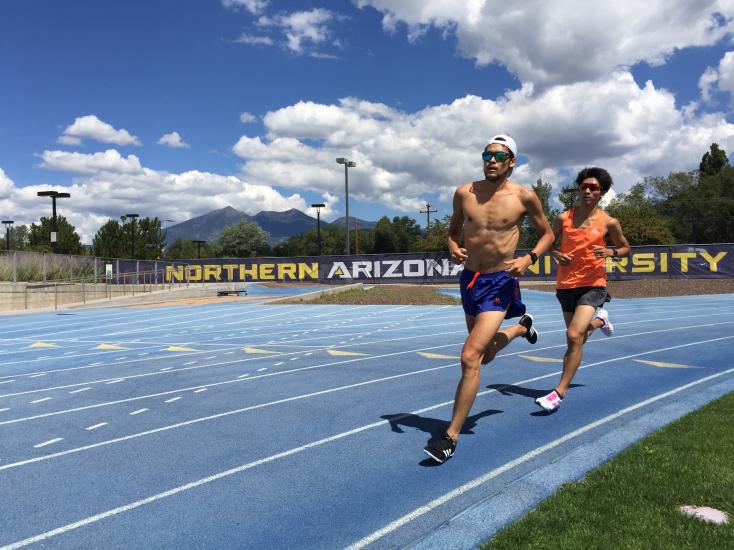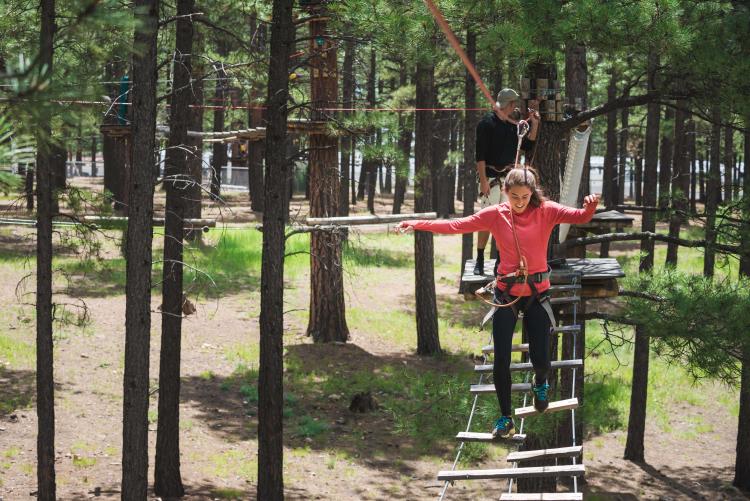Elevation Excellence
Unlock Your Athletic Potential with High Altitude Training

At any given time of year, you might find elite athletes in and around Flagstaff, Arizona. These current and future Olympians and triathletes flock to Flagstaff to train to be the best in their elected sports. Why? It’s our elevation, our leaders in the sports training space, and our community.
Flagstaff is the premier destination for high-altitude training among athletes. With its unique combination of altitude, natural beauty, and comprehensive training facilities, Flagstaff offers a conducive environment for runners, cyclists, swimmers, and triathletes seeking to enhance their endurance and performance levels. To learn more, we talked to Sports Physiologist Dan Bergland, owner of world-renowned sports management organization HYPO2, and professional chef Laura Chamberlin to explore why athletes choose Flagstaff over other elevated destinations.

The Benefits of High-Altitude Training
Altitude training offers athletes a unique physiological advantage. When training at higher altitudes, where oxygen levels are lower, the body responds by producing more red blood cells. This response is triggered by the release of erythropoietin (EPO), a hormone that stimulates the production of red blood cells. The increased red blood cell count improves the body's oxygen-carrying capacity, enabling athletes to perform at higher intensities and achieve greater endurance.
“Flagstaff is at 7,000 feet, so we're in the sweet spot. Much lower than 7,000 feet, you're not going to get the benefit of the red blood cell effect,” explains Bergland. “If you go much higher than 7,000 feet, then you're at an altitude where it's harder to train and to sleep, so athletes might actually get a little bit slower because they can't train as fast.”

Live High, Train Low Model
Another advantage for Flagstaff is its proximity to lower altitude areas like Sedona, Camp Verde, and Cottonwood. The "live high, train low" training model is widely adopted by athletes and coaches for altitude training.
“There are a few places in the world that might have this advantage. But in Flagstaff, athletes can live here and spend most of their day at altitude, yet go to lower altitudes where they can do even more higher-intensity training,” said Bergland. “By residing at higher altitudes in Flagstaff, athletes allow their bodies to adapt to the reduced oxygen environment. When they go to lower altitudes nearby, they can maintain training intensity while capitalizing on the benefits of altitude training.”

Preferred by Elite Athletes
While altitude training can benefit athletes of all levels, the commitment required makes it more common among elite athletes. The time and monetary investment involved in a three to four-week stay at altitude necessitates a dedicated approach. Elite athletes are more likely to embrace this commitment, knowing that the physiological advantages gained can significantly impact their performance. However, athletes at all levels can benefit from the unique training environment that Flagstaff offers.
Tailored Support for Athletes
Bergland's expertise in sports physiology, coupled with his experience providing elite sports training camp management services for teams visiting Flagstaff, makes this mountain town a favorite with athletes from around the world. From arranging transportation to hotels and coordinating training facilities to pre-arrival blood tests to identify iron levels, his team takes care of every aspect of the athletes' camp, ensuring a seamless and hassle-free experience. And this extends to assuring these athletes have access to the best nutrition.

The Role of Nutrition in High-Altitude Training
Proper nutrition plays a crucial role in optimizing athletes' performance and supporting their training goals. Chamberlin, a professional chef, collaborates with the teams who come to train with HYPO2 to develop customized menus that cater to their needs.
She works closely with the nutritionists and dieticians of each sports team to develop menus that align with their specific dietary requirements. While she provides a sample menu to every team, it serves as a starting point for discussions and customizations. Teams from various countries have distinct preferences, and she adapts her cooking style accordingly. Whether it's preparing Japanese cuisine for a Japanese team or focusing on pasta and protein for an Italian team, she ensures that the menu caters to the athletes' cultural and nutritional needs.
“I think nutritionally, this is a great asset for the teams. They're eating to fuel their bodies, and they're coming here specifically to train at altitude and increase their performance. The food they eat is really important for that, too,” said Chamberlin.
Providing Variety and Balance
To cater to the nutritional demands of athletes, Chamberlin offers a wide variety of dishes. From build-your-own Taco Bars to pasta-based meals, she crafts menus that strike a balance between macronutrients and provide the necessary fuel for athletes' training and recovery while still maintaining the nutritional integrity of the meals.
She goes that extra mile and delves into the nutritional aspects that can support athletes' performance during high-altitude training. She uses foods such as beets for their support of hemoglobin production, and she prioritizes using grass-fed, local beef for its omega-3 content, which aids the circulatory system. Additionally, she emphasizes the significance of avoiding sugars and processed foods, opting for homemade, clean meals that nourish the athletes.
Athletes visiting Flagstaff come with the specific goal of improving their performance through altitude training. By offering meals tailored to their dietary needs, Chamberlin ensures that these elite athletes are fueled with the necessary nutrients to enhance their training experience and maximize their potential.

Making Time For Fun
The elite athletes who come to Flagstaff make this city their home away from home. Each training camp requires extended stays for three to four weeks. Flagstaff's appeal extends beyond training facilities, which are exceptional with places like Northern Arizona University. These athletes often take advantage of the region's natural beauty.
Rather than running on treadmills, they can venture into the picturesque trails, mountains, and forests that surround Flagstaff, providing a refreshing change of scenery and an opportunity to connect with nature during high-altitude workouts.
What keeps teams coming back, again and again, is Flagstaff itself and its location to other attractions. One of the more popular things these athletes like to do is the Flagstaff Extreme Adventure Course which allows them to test their limits on outdoor adventure courses. And when they have more downtime, day trips are a breeze, with the Grand Canyon, Sedona, and Scottsdale nearby for even more outdoor adventures and shopping excursions.